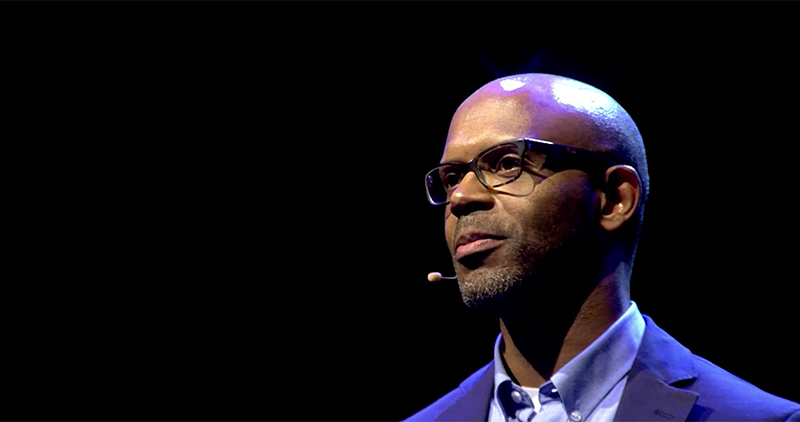Is this what sports fans want?
Professor grapples with technology's evolving role in sports culture

Rayvon Fouché has spent years grappling with the role technology plays in how we digest and interpret sports.
These days, the director of Purdue’s American Studies program is trying to find a new way to tell that story. As a member of an advisory team helping the Smithsonian Institution create an exhibition on technology in sport for the National Museum of American History, Fouché and his committee mates face a quandary.
“One of the bigger ethical questions that we’re struggling with,” Fouché said, “is when you have finite space in a museum, how do you effectively represent technology in sport in that context?”
It’s a complicated story to tell, and Fouché should know. He wrote the book on it.
His Game Changer: The Technoscientific Revolution in Sports (Johns Hopkins University Press, 2017) examines the many ways that innovation – materials, training, nutrition, medicine – has eroded the authenticity of athletic achievement.
“Sport has always been technological from the beginning. It’s always had equipment, rules, organizations, and there have been moments when the technology seems to be more important than the athletes,” Fouché said. “We as a society have always been invested in the athletes in the athletic tradition. However, in the last 50 years or so, technologies from pharmaceuticals to super hydrodynamic swimsuits to all kinds of things have really shaped the games which we play.
“We’re at this moment, I would argue, that we’re going to have to make some really fundamental decisions about what we want sport to be and look like in the future.”
Performance-enhancing drugs are the innovation that has drawn the most attention over the past few decades, and understandably so. But Fouché argues that material innovations have had a comparable impact on athletic performance, reducing the importance of high-level skill.
For example, more than 130 world swimming records fell in the 18-month period after Speedo launched a now-banned body-length polyurethane suit in 2008. Golfers now tee off with drivers constructed from titanium. Pole vaulters power themselves over the bar with carbon-fiber rods. And Nike in recent years insisted that the carbon-fiber plates embedded in its running shoes helped marathon runners conserve energy, carving valuable seconds off their times.
“The ‘tools’ and equipment of sport can no longer be understood in instrumental terms as benign artifacts of the game,” Fouché wrote in Game Changer. “The long-cherished belief that the only
way these artifacts influence competition is through the hands, minds, and bodies of skilled athletes must give way. These technoscientific artifacts are more than instrumental tools. They are devices that in the recent past have pulled sporting outcomes decidedly away from the competitors, governing institutions, and fans to the technoscientific.
“As these sport governing bodies, consuming publics, and athletes work to extract and diminish the technoscientific realities of sport, technoscience has and always will be an integral component of sporting culture.”
With that reality in mind, governing bodies are forced to contend with issues that technological innovation creates. For example:
· Auto racing organizations adjust their rules to reduce the importance of engineering and increase the value of a driver’s skill.
· College baseball’s new regulations governing bat composition have reduced home runs, replacing the power game of a decade ago with today’s brand of small ball.
· PGA Tour venues continuously lengthen their courses in order to maintain a reasonable level of difficulty for golfers who are bigger and stronger, and using equipment that is far more advanced, than those in past eras.
Fouché was intrigued by the story of South African sprinter Oscar Pistorius, a double-leg amputee who won a court battle that allowed him to compete in the 2012 Summer Olympics. The International Association of Athletics Federations (IAAF) had argued that his artificial limbs gave Pistorius an unfair advantage.
With the 2020 Tokyo Games approaching, a similar scenario exists with German long jumper Markus Rehm. Following a wakeboarding accident at age 14, Rehm’s right leg was amputated below the knee. He now jumps off a carbon-fiber bladed prosthesis, earning him the nickname, “The Blade Jumper.”
Like Pistorius, the Paralympic champion has battled to compete in the Olympic Games – thus far unsuccessfully – against governing bodies who say the prosthesis is simply too good.
“The studies that have been done about him say on the run-up, he has potentially a disadvantage, but potentially an advantage when he jumps,” Fouché said. “His personal record would have won the gold medal in the last three Olympics.”
Technology’s encroachment does not end at the edge of the track, playing field, or court, however. As legalized sports gambling spreads, the sports data revolution continues, and sports broadcasts incorporate new elements, the way viewers watch sporting events will also change. As with his questions concerning competitive innovation, Fouché wonders what these changes mean for the future of sport.
Fouché pointed toward broadcast technology proposed by Steve Ballmer – former CEO of Microsoft and current owner of the NBA’s Los Angeles Clippers – that overlays traditional TV broadcasts with AI-driven data and animations.
“There’s a massive amount of data being created about the performance of the game, even down to the level of asking people, ‘How do we want to even watch games?’” Fouché said. “They have some mockups where, say for instance, someone goes up for a dunk and instead of it just going through the net, one of the things I saw was Taco Bell tacos drip-dropping out of the bottom of the basket during the game.
“So you can see where this is going is every inch of the viewer experience is potentially a place to sell product and product placement. For me, the question is whether that is how we want sport to go, because we’re already at this place.”